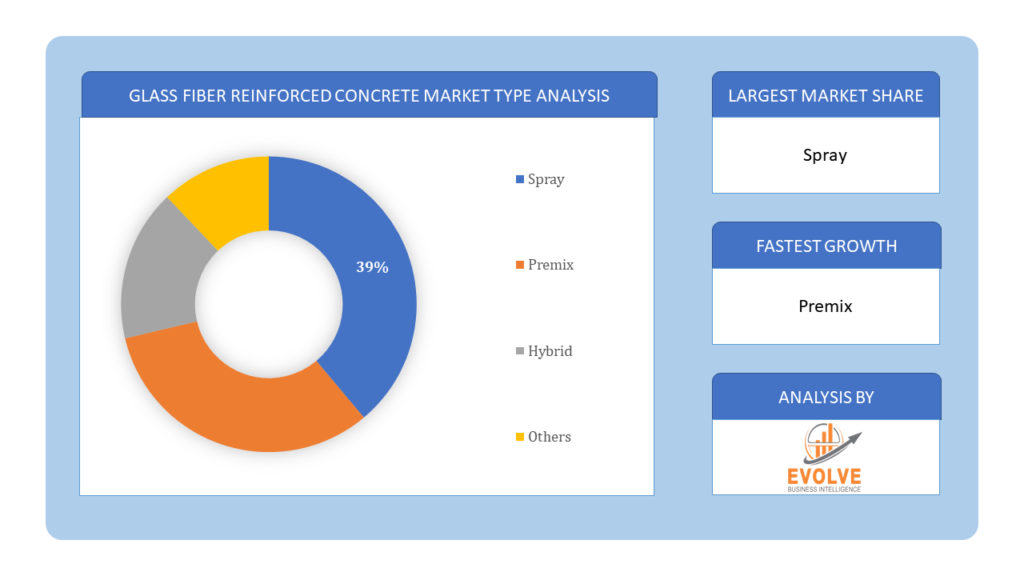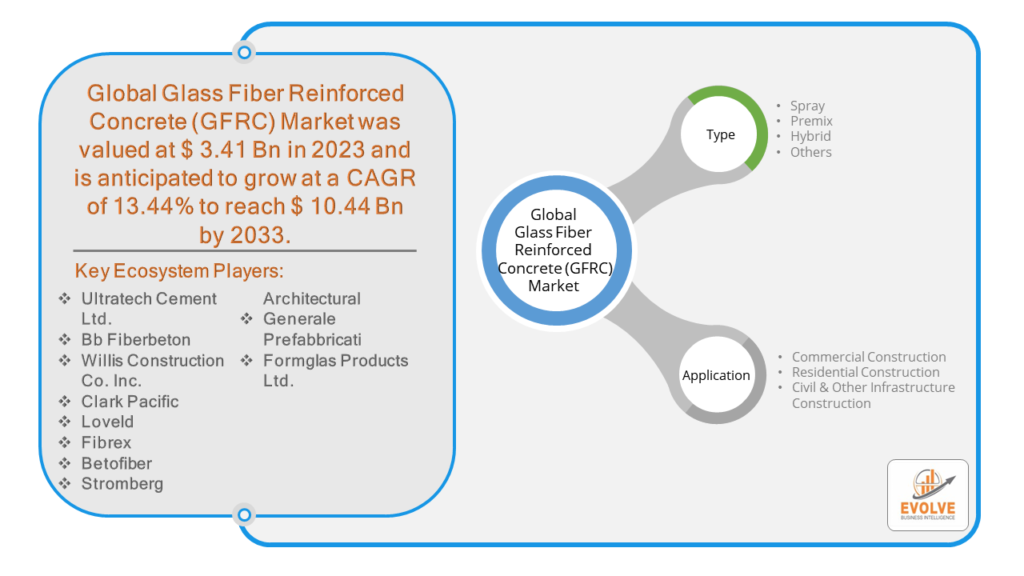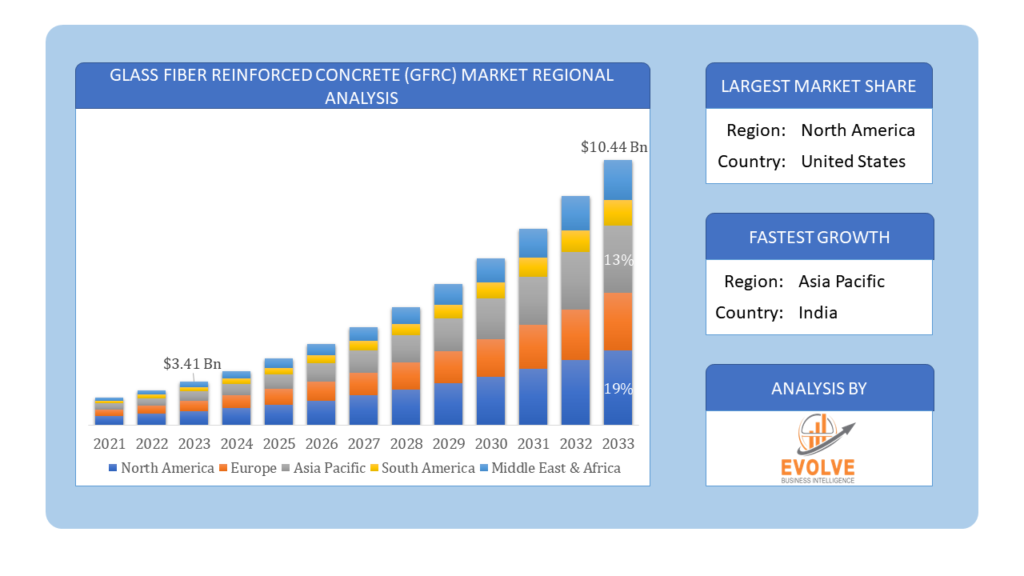Glass Fiber Reinforced Concrete (GFRC) Market Overview
The Glass Fiber Reinforced Concrete (GFRC) Market Size is expected to reach USD 10.44 Billion by 2033. The Glass Fiber Reinforced Concrete (GFRC) industry size accounted for USD 3.41 Billion in 2023 and is expected to expand at a CAGR of 13.44% from 2023 to 2033. Glass Fiber Reinforced Concrete (GFRC) is a composite material consisting of a cementitious matrix reinforced with fine glass fibers. The glass fibers, typically alkali-resistant, are dispersed throughout the concrete mix to enhance its tensile strength, flexibility, and durability. GFRC offers advantages such as reduced weight, high impact resistance, and intricate moldability, making it a preferred choice for architectural cladding, decorative panels, countertops, and other structural and decorative applications in construction.
Global Glass Fiber Reinforced Concrete (GFRC) Market Synopsis
The post-COVID-19 pandemic has catalyzed a notable shift in the Glass Fiber Reinforced Concrete (GFRC) market dynamics, with an evident surge in demand driven by a heightened emphasis on resilient and sustainable construction practices. As the construction industry rebounds from the pandemic’s disruptions, GFRC has emerged as a favored material due to its durability, versatility, and eco-friendly attributes. With increased awareness of the importance of resilient infrastructure and sustainable building solutions, GFRC is experiencing heightened adoption across various construction projects globally. Additionally, the pandemic has accelerated digital transformation within the industry, leading to greater utilization of advanced technologies for design, manufacturing, and distribution processes, further augmenting the growth prospects of the GFRC market.
Glass Fiber Reinforced Concrete (GFRC) Market Dynamics
The major factors that have impacted the growth of Glass Fiber Reinforced Concrete (GFRC) are as follows:
Drivers:
Ø Advancements in Construction Technology
The ongoing advancements in construction technology have significantly boosted the demand for high-performance building materials like GFRC. With its exceptional strength-to-weight ratio and durability, GFRC is increasingly preferred in architectural designs, offering architects and engineers greater flexibility and innovation in construction projects.
Restraint:
- High Initial Cost and Perception
The widespread adoption of GFRC is its initial cost compared to conventional building materials. Additionally, there may be lingering perceptions regarding the durability and performance of GFRC among some segments of the construction industry. Overcoming these cost barriers and addressing misconceptions through education and demonstration of GFRC’s long-term benefits are crucial for market expansion.
Opportunity:
⮚ Sustainable Construction Practices
The growing emphasis on sustainable construction practices presents a significant opportunity for the GFRC market. GFRC offers several environmental benefits, including reduced material usage, lower transportation costs due to its lightweight nature, and the potential for recycling at the end of its lifecycle. As sustainability becomes a key consideration in construction projects, GFRC’s eco-friendly characteristics position it favorably for increased adoption.
Glass Fiber Reinforced Concrete (GFRC) Segment Overview
By Type
 Based on Type, the market is segmented based on Spray, Premix, Hybrid, and Others. The Spray segment within the Glass Fiber Reinforced Concrete (GFRC) market is primed for significant expansion due to its ability to facilitate rapid and efficient application processes, reducing labor costs and project timelines. Additionally, advancements in spray technology have enhanced the precision and quality of GFRC applications, making it an increasingly attractive option for architects and contractors seeking both aesthetic appeal and structural integrity.
Based on Type, the market is segmented based on Spray, Premix, Hybrid, and Others. The Spray segment within the Glass Fiber Reinforced Concrete (GFRC) market is primed for significant expansion due to its ability to facilitate rapid and efficient application processes, reducing labor costs and project timelines. Additionally, advancements in spray technology have enhanced the precision and quality of GFRC applications, making it an increasingly attractive option for architects and contractors seeking both aesthetic appeal and structural integrity.
By Application
Based on the Application, the market has been divided into Commercial Construction, Residential Construction, and Civil & Other Infrastructure Construction. The Commercial Construction segment in the Glass Fiber Reinforced Concrete (GFRC) market is positioned for substantial growth driven by the material’s versatility in creating intricate architectural designs and its ability to meet stringent safety and durability requirements, particularly in high-traffic areas. Additionally, the increasing demand for sustainable building solutions aligns with GFRC’s eco-friendly characteristics, making it an attractive choice for commercial developers looking to enhance both aesthetic appeal and environmental responsibility in their projects.
Global Glass Fiber Reinforced Concrete (GFRC) Market Regional Analysis
Based on region, the global Glass Fiber Reinforced Concrete (GFRC) market has been divided into North America, Europe, Asia-Pacific, the Middle East & Africa, and Latin America. North America is projected to dominate the use of the Glass Fiber Reinforced Concrete (GFRC) market followed by the Asia-Pacific and Europe regions.
 North America Market
North America Market
The North American market dominates the Glass Fiber Reinforced Concrete (GFRC) market due to several factors including robust infrastructure development, stringent building regulations, and a high demand for innovative construction materials. Additionally, North America boasts a mature construction industry with a strong emphasis on quality and performance, further driving the adoption of GFRC for various architectural applications. Furthermore, the region benefits from extensive research and development initiatives, fostering continuous advancements in GFRC technology and widening its applications across diverse construction projects.
Asia-Pacific Market
Indeed, the Asia-Pacific region exhibits the highest CAGR in the Glass Fiber Reinforced Concrete (GFRC) market. This robust growth trajectory is primarily fueled by rapid urbanization, infrastructure development initiatives, and increasing construction activities across countries like China, India, and Japan. As these economies continue to invest heavily in residential, commercial, and industrial projects, there is a growing demand for advanced construction materials such as GFRC, which offer superior durability, design flexibility, and sustainability. Additionally, the Asia-Pacific region’s evolving regulatory landscape, coupled with rising environmental consciousness, further amplifies the adoption of eco-friendly building solutions such as GFRC, contributing to its remarkable CAGR in the region.
Competitive Landscape
The Global Glass Fiber Reinforced Concrete (GFRC) market is highly competitive, with numerous players offering a wide range of solutions. The competitive landscape is characterized by the presence of established companies, as well as emerging startups and niche players. To increase their market position and attract a wide consumer base, the businesses are employing various strategies, such as product launches, and strategic alliances.
Prominent Players:
- Ultratech Cement Ltd.
- Bb Fiberbeton
- Willis Construction Co. Inc.
- Clark Pacific
- Loveld
- Fibrex
- Betofiber
- Stromberg Architectural
- Generale Prefabbricati
- Formglas Products Ltd.
Key Development:
On May 21, Chapman Taylor Architects utilized GFRC to clad the offices of the German Aerospace Center, creating a striking façade featuring black and copper hues. The design of these GFRC facades was crafted by the Rieder Group, based in Austria.
Scope of the Report
Global Glass Fiber Reinforced Concrete (GFRC) Market, by Type
- Spray
- Premix
- Hybrid
- Others
Global Glass Fiber Reinforced Concrete (GFRC) Market, by Application
- Commercial Construction
- Residential Construction
- Civil & Other Infrastructure Construction
Global Glass Fiber Reinforced Concrete (GFRC) Market, by Region
- North America
- US
- Canada
- Mexico
- Europe
- UK
- Germany
- France
- Italy
- Spain
- Benelux
- Nordic
- Rest of Europe
- Asia Pacific
- China
- Japan
- South Korea
- Indonesia
- Austalia
- Malaysia
- India
- Rest of Asia Pacific
- South America
- Brazil
- Argentina
- Rest of South America
- Middle East & Africa
- Saudi Arabia
- UAE
- Egypt
- South Africa
- Rest of Middle East & Africa
| Parameters | Indicators |
|---|---|
| Market Size | 2033: $10.44 Billion |
| CAGR | 13.44% CAGR (2023-2033) |
| Base year | 2022 |
| Forecast Period | 2023-2033 |
| Historical Data | 2021 |
| Report Coverage | Revenue Forecast, Competitive Landscape, Growth Factors, and Trends |
| Key Segmentations | Type, Application |
| Geographies Covered | North America, Europe, Asia-Pacific, Latin America, Middle East, Africa |
| Key Vendors | Ultratech Cement Ltd., Bb Fiberbeton, Willis Construction Co. Inc., Clark Pacific, Loveld, Fibrex, Betofiber, Stromberg Architectural, Generale Prefabbricati, Formglas Products Ltd. |
| Key Market Opportunities | • Urbanization trends • Technological Advancements |
| Key Market Drivers | • Increasing demand for eco-friendly construction materials • Growing infrastructure projects |
REPORT CONTENT BRIEF:
- High-level analysis of the current and future Glass Fiber Reinforced Concrete (GFRC) market trends and opportunities
- Detailed analysis of current market drivers, restraining factors, and opportunities in the future
- Glass Fiber Reinforced Concrete (GFRC) market historical market size for the year 2021, and forecast from 2023 to 2033
- Glass Fiber Reinforced Concrete (GFRC) market share analysis at each product level
- Competitor analysis with detailed insight into its product segment, Government and defense strength, and strategies adopted.
- Identifies key strategies adopted including product launches and developments, mergers and acquisitions, joint ventures, collaborations, and partnerships as well as funding taken and investment done, among others.
- To identify and understand the various factors involved in the global Glass Fiber Reinforced Concrete (GFRC) market affected by the pandemic
- To provide a detailed insight into the major companies operating in the market. The profiling will include the Government and defense health of the company’s past 2-3 years with segmental and regional revenue breakup, product offering, recent developments, SWOT analysis, and key strategies.








